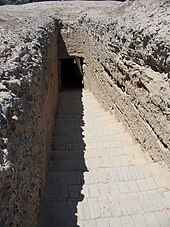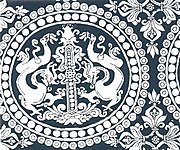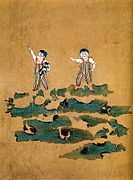Astana Cemetery
 A view of the Astana Cemetery | |
| Location | |
|---|---|
| Region | Xinjiang |
| Coordinates | 42°52′55″N 89°31′44″E / 42.882°N 89.529°E |
The Astana Cemetery (
Description of the tombs


The tombs consist of sloping passageways leading downwards for 4 or 5m to a rockcut entrance, about a meter wide and over a meter high. A step then leads into a brick-lined chamber, square or oblong and measuring between two and four meters wide, three to four meters long and up to two meters high. Some tombs contain one or two narrow
The body or bodies were shrouded in textiles. A silver oval shaped eye-mask and an oval piece of silk covered the face. Sometimes coins were used instead of these eye-masks. The origin of placing a coin inside the mouth is unclear: Stein saw parallels with the Greek custom of providing the deceased with the fare for the ferryman of Hades, but Chinese scholars have argued the same custom is seen in Chinese burials from the first millennium BC.
The bodies were originally placed inside wooden coffins, propped up with bundles of paper, and with small articles of personal use and models of garments made from paper and silk—such as shoes and hats—placed alongside them. Other offerings were placed inside wooden or pottery vessels near the head of the coffin on a wooden pedestal. Many of the vessels were painted with a distinctive pattern of white dots and red lines. Remains of food, desiccated but identifiable, were found in some of the unrobbed tombs and included grapes, plums, pears, pieces of meat and wheat. Several tombs contained well-preserved pastries, including a jam tart.
According to Chinese beliefs, the afterlife was very similar to the life from which they had departed, and the deceased were therefore buried with goods and money they would require. However, it was sufficient to bury models and not original objects. These include human figurines, animals, clothes, ornaments and musical instruments. They were listed on a written inventory, also placed inside the tomb. Many tombs also contained epitaph tablets for the dead and a funerary banner showing the Chinese mythological figures, Fuxi and Nüwa.[3]
There are various Tang dynasty figurines and Chinese silk paintings found in the cemetery.[3][4] A new pavilion has been built outside the cemetery the centerpiece of which is a large statue of Fuxi and Nüwa.
History of the area
At the start of the first millennium this area was occupied by the
Excavations
The site was visited by many of the archaeological expeditions sent by various imperial powers to Chinese Central Asia in the first two decades of the 20th century, among them the Japanese expeditions of Ōtani Kōzui in 1902, the German expeditions led by Albert Grünwedel (November 1902–March 1903) and Albert von Le Coq (1904–1907, 1913–1914), and the Russian Sergey Oldenburg between 1909 and 1910. The archaeologist Aurel Stein also went to Astana in 1907, then returned for longer in December 1914.
Chinese archaeologists have undertaken over ten excavations at the Astana and Gaochang graveyards from 1959 onwards, unearthing 456 tombs, 205 of which contained manuscript fragments. Most of these fragments were originally part of funerary objects—paper shoes, paper hats, paper belts, and paper coffins—made from discarded documents. Two thousand documents were found which yield insights into the life of the people there.[5]
Objects from the tombs

Material from the Russian explorations was originally deposited in the Asiatic Museum of St. Petersburg. Later the manuscripts were transferred to the St Petersburg Branch of the Institute of Oriental Studies of the Russian Academy of Sciences. The Japanese collections were taken to

The Japanese Government had to repurchase them after the war and, along with some other items bought from other individuals, the collection was deposited in the Oriental Section of
Many thousands of artifacts found by Chinese archaeologists since 1958 were removed to the Ürümqi Museum.[5] Objects from the tombs from various excavations have been displayed in several exhibitions.[6][7]
Gallery
Sichuan brocade
Sichuan brocade fabrics unearthed at Astana Cemetery.
-
Animals and trees
-
Double dragon within pearl roundels
-
Drinking scene of two Byzantines or Central Asians within a pearl roundel
-
Boar head within a pearl roundel
Paintings
-
Tang dynasty musician
-
Woman
-
Courtesan
-
Dancer
-
Servant
-
Children
-
Weiqiplayer
Notes
- ^ Mahler, Jane Gaston (1959). Westerners Among The Figurines Of The Tang Dynasty Of China. Istituto Italiano Per Il Medio Ed Estremo Oriente. p. 30.
- ^ Skaff, Jonathan (1998). "The Sasanian and Arab-Sasanian Silver Coins from Turfan: Their Relationship to International Trade and the Local Economy". Asia Major. 11: 67–115.
- ^ ISBN 1-74059-687-0.
Astana Graves tang paintings.
- ^ "The Astana Graves - Underground Museum - China culture". Archived from the original on September 2, 2011. Retrieved August 19, 2010.
- ^ ISBN 978-0195159318.
- ISBN 978-0-937809-24-2.
- ^ Whitfield, Susan (2004). The Silk Road: Trade, Travel, War and Faith. The British Library.
References
- Hopkirk, Peter. Foreign Devils on the Silk Road. John Murray (Publishers), London, 1980.
- Xinjiang Cultural Board. The Ancient City of Gaochang (高昌故城). Ürümqi, China, 2005.













